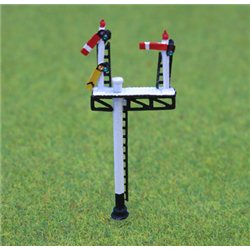Leading wheels, also known as pilot wheels or guide wheels, serve an important purpose on a steam locomotive. They...
No products
Product successfully added to your shopping cart
There are 0 items in your cart. There is 1 item in your cart.
Search Tips
Christmas and New Year
We are dispatching orders every weekday apart from Christmas Day, Boxing Day and New Year's Day.
If you order is time critical, select next day delivery at checkout.
The shop in Sandown is closed from 25th December, reopening on 30th December.
Where should I position semaphore signals on my layout?
Semaphore signals are an important part of any model railway layout as they help to control the movement of trains and add a realistic touch to the overall scene. When it comes to positioning semaphore signals on a layout, there are a few factors to consider.
Firstly, the purpose of the signal will need to be established. Semaphore signals are typically used to indicate the status of a particular section of track, such as whether it is clear for a train to proceed or if there is a train ahead. Therefore, it makes sense to position semaphore signals in locations where they can be easily seen by the train operators.
In terms of placement, semaphore signals are usually positioned at strategic points along the track, such as at junctions, sidings or stations. These are areas where train movements need to be controlled and where signals can provide clear and visible indications to the train operators.
It is also important to consider the scale of the layout when positioning semaphore signals. Different scales, such as OO/HO, N and TT gauges have different recommended distances between signals. For example, in OO/HO gauge, signals are typically placed around 3-4 feet apart, while in N scale, they may be placed closer together due to the smaller size of the models.
Additionally, modellers should consider the visual appeal of the layout when positioning semaphore signals. Placing them in areas where they can be easily seen by observers, such as near the front of the layout or in scenic spots, can add interest and realism to the scene.
In summary, when positioning semaphore signals on a layout, consider their purpose, visibility to train operators, recommended distances for the scale in use and the overall visual appeal of the layout. By carefully planning their placement, modellers can enhance the realism and functionality of their model layouts.
Click here to receive the tips weekly in your mailbox. You can unsubscribe at any time.










